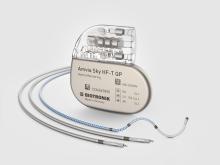Evaluating the utility of procedural diagnostics in deciding when and where to place a stent, as well as the safety and efficacy of Passeo-18 Lux DCB associated to Pulsar-18 BMS placement
BIOTRONIK announced the two-year-results from the BIOLUX P-III BENELUX all-comers registry, presented by Principal Investigator Prof. Frank Vermassen at CIRSE 2023 in Copenhagen, Denmark.1 The prospective, international, multicenter post-market registry evaluated the safety and efficacy of the Passeo®-18 Lux® drug-coated balloon (DCB) catheter in isolated popliteal artery lesions. This indication is considered a difficult vessel bed to treat due to its biomechanical constraints that usually preclude the placement of stents. BIOLUX P-III BENELUX registry enrolled 99 patients in Belgium, the Netherlands, and Luxembourg with Rutherford 2-5 disease and at least two centimeters of healthy vessel segment between lesions in the popliteal artery and lesions in the distal superficial femoral artery. All patients were treated with the Passeo-18 Lux DCB. The bail-out stenting rate was 14%. At 24 months: “We face a scarcity of data evaluating endovascular therapy for isolated popliteal artery lesions, known
Indicated for balloon dilatation of the stenotic portion of a lower limb artery for the purpose of improving perfusion.*
Indicated to dilate stenosis in the renal, iliac1, femoral, popliteal and infrapopliteal arteries and for the treatment of obstructive lesions of native or synthetic arteriovenous dialysis fistulae.*
Drug-Releasing Pantera Lux PTCA Balloon Catheter Registry
Today BIOTRONIK announces the enrollment of the first patient in the Leave Nothing Behind-Trial. The first implantation was performed by Dr. Mohamed Ayoub at the Heart and Diabetes Center North Rhine-Westphalia, Germany. The trial aims to demonstrate the non-inferiority of drug-coated balloons (DCB) or DCBs in combination with Resorbable Magnesium Scaffolds (RMS) compared to drug-eluting stents (DES) in chronic total occlusions (CTO) in percutaneous coronary interventions (PCI). The prospective, single-center, single-blind, randomized trial evaluates the efficacy of the Pantera® Lux® DCB and Freesolve® RMS compared to Orsiro® Mission* DES in 166 CTO patients. “We want to investigate whether treatment with DCBs ─ used alone or with Resorbable Magnesium Scaffolds as a bailout option ─ is non-inferior to drug-eluting stents in patients with chronic total occlusions,” summarized Principal Investigator Dr. Mohamed Ayoub, Heart and Diabetes Center North Rhine-Westphalia, Bad Oeynhausen, German
Peripheral drug-coated balloons (DCBs) are minimally invasive angioplasty balloons coated in paclitaxel, an anti-proferative drug that is released up dilatation of the balloon within a peripheral artery to treat peripheral artery disease (PAD). Paclitaxel reduces the rate of restenosis and reinterventions, as shown in many clinical trials.
Our broad range of products work to restore blood flow to vessels of the heart (coronary) and body (peripheral) that are narrowed or blocked. We produce a full range of stent systems, balloon catheters and guide wires for patients with coronary and peripheral artery disease.BIOTRONIK is a true innovator in the field, having introduced Pulsar, the world's first 4 F-compatible stent for treating long lesions, in 2009 and Orsiro, the industry's first hybrid drug-eluting stent, in 2011. Over the years our wide range of vascular intervention innovations include Orsiro DES, Resorbable Magnesium Scaffold, Drug Coated Balloon Catheters, Multifunctional Catheters and many more. Patient well being is our top priority and has been for 60 years.
